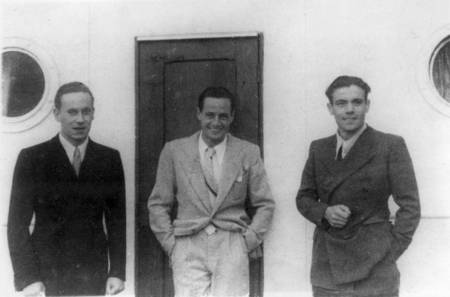Mantelli
Adriano
San Marino
di Parma 13-02-1913 – 06-05-1995 Firenze
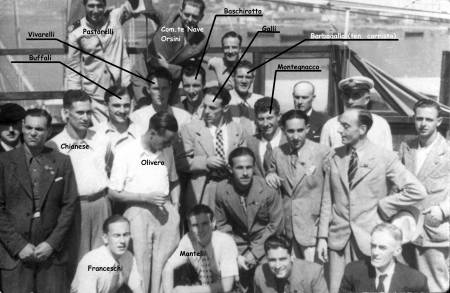
|
Spediz_GCE_1
La Spezia - primi di agosto del 1936
La missione "segreta" composta dai piloti: S.Ten. Dante Olivero (6° Stormo), S.Ten. Adriano Mantelli (1° Stormo), S.Ten. Giorgio Franceschi (4° Stormo),
Serg. Raffaele Chianese (4° Stormo), M.llo Bruno di Montegnacco (1°
Stormo), Serg. Gian Lino Baschirotto (1° Stormo), Serg. Achille Buffali
(6° Stormo), Serg. Raul Galli (1° Stormo), Serg. Manlio Vivarelli
(4° Stormo) e dagli specialisti: Cresti, Brunetto, Gerbino Grego, Barzacchi.
Trattasi di una Squadriglia al completo di uomini e materiali, posta sotto
il comando del Olivero.
|
|
Spediz_GCE_2
??? (1°), ??? (2°), Adriano Mantelli (3°).
|
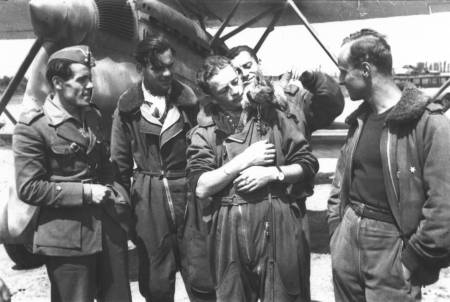
|
bas066
Spagna - 1936
Adriano Mantelli e' il primo a sinistra.
|
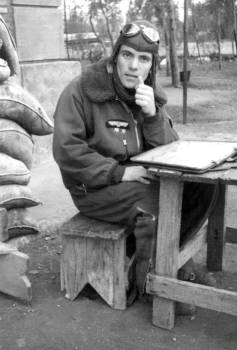
|
deq414
Spagna - 1936
Il Ten. Adriano Mantelli.
|
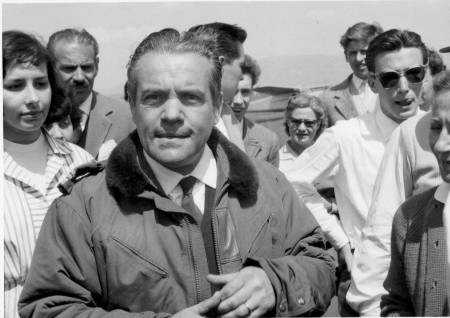
|
ron343
Ronchi dei Legionari - "Giornata dell'Ala", primi anni '50
Il Col. Adriano Mantelli, pluridecorato e collaudatore dell'A.M. e' anche
un campione aliantista e si esibisce con l'aliante "Canguro" in occasione
della manifestazione aerea organizzata dall'avv. Furio Lauri, fondatore della
Meteor.
|
|
ron343
Ronchi dei Legionari - 1953
Il Col. Adriano Mantelli ad una manifestazione aerea sull'aeroporto di Ronchi
ove si esibirà da grande campione di pilota d'aliante. Mantelli, classe
1913, inizia ad appassionarsi agli alianti fin da giovane e ne diventa pilota
e progettista. Nel 1934 diventa pilota della Regia Aeronautica e assegnato
al 1° Stormo di Campoformido. Nel 1936 partecipa alla Campagna di Spagna
e consegue dieci abbattimenti e due medaglie d'argento al V.M. Rientrato dalla
Spagna diventa collaudatore e sperimentatore a Guidonia. Durante il Secondo
Conflitto vola sul MC 200 ed MC 202. Si spegne nel 1995.
|
per
gentile concessione
Biplane fighter aces
http://surfcity.kund.dalnet.se/italy_mantelli.htm
Adriano Mantelli was born on 13 February 1913 in Cortile San Marino di
Parma, his father being a regular soldier.
He became interested in aviation at a young age, and from 1929, he avidly
participated in model flying competitions with aircraft that he had built
himself. From 1931, Mantelli dedicated himself to glider design, and the
following year he obtained his glider flying licence. Concurrently, he graduated
from the Parma Regio Istituto d’Arte (Royal Art Institute) - a school
attended by fellow would-be ace Giuseppe Cenni.
Indeed, both men would also commence their flying careers together. Joining
the Regia Aeronautica in 1934, Mantelli gained his military ‘wings’ and became
a fighter pilot. He was commissioned (in Servizio Permanente Effettivo) on
7 October 1934. Initially, he flew CR.20s with the 1o Stormo Caccia.
In 1935, he transferred to a Squadriglia equipped with CR.32s that had been
formed at the Reparto Sperimentale Volo (Experimental Flight Establishment)
at Guidonia expressly to defend Rome. Finally, Mantelli joined the newly
formed 6o Stormo Caccia at Ravenna, in Emilia, which was led
by Colonnello Vincenzo Velardi. The latter officer subsequently commanded
Italian airmen in Spain. He served as a volunteer in the Spanish Civil War,
using the nom de guerre ”Arrighi”. By the end of August, after the
first 12 CR.32s, and their pilots, had reached Melilla, three more had been
sent to Majorca and nine were offloaded in the port of Vigo de Galicia,
on Spain’s Atlantic coast, from the Spanish ship Ebro. The latter
had been renamed Aniene in Italy so that it could run contraband under
a flag of convenience.
The nine CR.32s delivered to Vigo de Galicia were unloaded on the night
of 27 August, although the presence of a British naval vessel in the port
at the same time meant that this operation could not be completed in secrecy.
Nine pilots under the command of Tenente Dante Olivero (from 6o
Stormo) were also on board Aniene, and each of them had a false identity.
Amongst the aviators were Sottotenente Mantelli (’Arrighi’) and Sergenti
Brunetto di
Montegnacco (’Antonio Romualdi’), GianLino Baschirotto
(’Edoardo Giri’) and Raffaele Chianese,
while five groundcrew provided technical support. The men and their machines
then travelled by train southwards along the Vigo-Orense-Salamanca-Caceres-Seville
route, which was controlled by Nationalist forces that had recently occupied
the eastern Extremadura to unite the occupied zones of southern and north-western
Spain. The reassembly of the nine aeroplanes, which were destined for the
Segunda Escuadrilla de Caza del Tercio (2a Escuadrilla de Caza
del Tercio), commenced after the three-day journey had ended in Tablada on
30 August.
...........................................
In the spring of 1937, Mantelli returned to Italy and eventually became
a test pilot at the Guidonia Aircraft Experimental Centre near Rome. On 12
February 1940, he was promoted to Capitano. He transferred to the Direzione
Costruzioni Aeronautiche (Aircraft Construction Directorate) in Naples. In
1943, he still served in the Direzione Costruzioni Aeronautiche. Mantelli
flew his last combat mission on the morning of 8 September 1943 - the day
of Italy’s Armistice with the Allies - in a Macchi C.202 against a formation
of USAAF B-17 bombers targeting Frascati. As a test pilot and flight instructor
for the new Fiat G.55 fighter, he then served in the Aeronautica della Repubblica
Sociale Italiana (Italian Social Republic Air Force). Mantelli ended the
war with 9 biplane victories. During his career he had been decorated with
two Medaglia d’argento al valor militare, one Medaglia d’argento al valor
aeronautica, one Croce al merito di guerra, one Medaglia commemorativa della
campagna di Spagna and one Medaglia di benemerenza per i volontari della
guerra Spagna. A post-war trial cleared Mantelli of 'collaboration' by serving
with the Aeronautica della Repubblica Sociale Italiana. He continued to design
and construct light civil aircraft in Italy and Argentina prior to re-joining
the Italian air force in 1951. Rising through the ranks, Mantelli became
a Generale and eventually retired in Rome. Remaining active, he died
from a sudden illness at the age of 82 whilst waiting for a train at Florence
station on 6 May 1995. During his long flying career, Mantelli had flown more
than 10,000 hours in 200+ aircraft types, setting several international light
aircraft records in the process.
Biplane victories: 10 and 6 shared destroyed.

